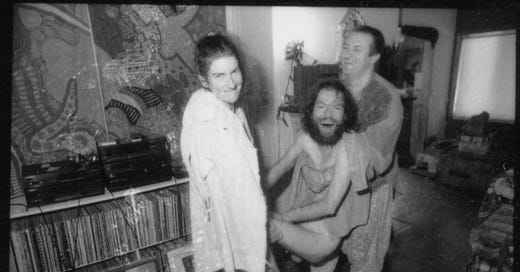Creating A Masterpiece
Written by Frank Moore January 19, 2000.
Published in Lummox Journal, March 2000.
An artist starts, let’s say, a painting with a set idea of what he is going to paint. Sooner or later he makes a “mistake” -- a color or a line which doesn’t fit in the original idea -- which “ruins” the painting. When this happens most people give up, thinking that they are not cut out to be artists, and withdraw back into the common existence. Others try to pretend that they didn’t make the mistake, that the color or line isn’t there on the canvas. They go on painting as before. When they are done, they have painted the shadow of what they wanted. Moreover, this shadow is covered with a haze. Others keep starting over whenever they make mistakes, not accepting any mistakes. They are rewarded for their endurance with the perfect copy of the thought form which they had held for all this time. They are rewarded by what they think they want to create. Their thought form has been brought down into the material plane. The creation is perfect. But it is not a masterpiece. It is perfect within the limitations placed around it by the rigidness of the artist. The work is perfect, but not free.
A masterpiece is perfect and free. The master artist paints an adventure in color, words, or notes. What others see as mistakes, he sees as challenges, boxes out of which he has worked as the basis on which he creates a totally new, fresh pattern. These challenges, boxes, keystones, keep appearing as he works, demanding the artist’s flexibility. If the artist looks back, trying to hold on to what he thought the painting was or would be, he gets trapped in a box out of which he must battle or be turned into a rigid, bitter pillar of salt. The artist has to keep his whole attention on the swirling colors in front of him in order to be the creator.
To create a masterpiece, the artist has to use and risk every bit of himself. But he also has to create with God, for God is the one who creates what most people call mistakes, and that the master artist sees as his tools and materials. God does not create for the artist. God just provides the tools, the guiding bumps. It is up to the artist’s free will whether he creates or gets dragged down by the weight of the tools. When the artist is creating, he feels no weight.
The most important masterpiece is a lifetime. This is a statement of hard fact. Creating a masterpiece in every day living is governed by the same rules as creating a masterpiece in paint, but much harder because the artist is also the canvas. In every period of time, in every land, there are a few masterpieces of art and writing. But a masterpiece lifetime is much rarer.
From the book, “Frankly Speaking: A Collection of Essays, Writings & Rants” by Frank Moore, published by Inter-Relations in 2014.



